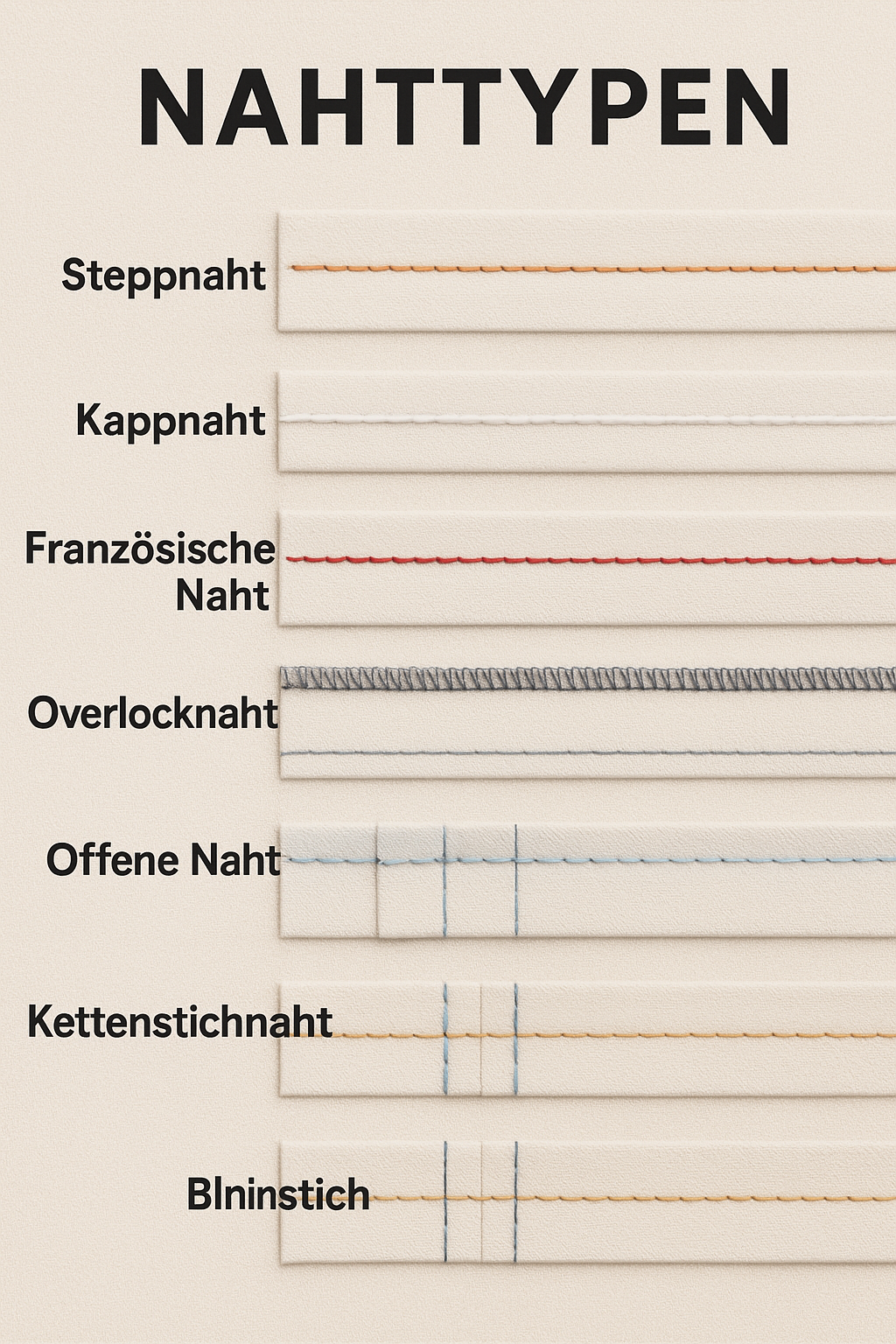What Are Nahttypen?
Nahttypen is the German term for “seam types” — the lifelines of fashion, upholstery, and textile manufacturing. Seams not only hold fabrics together but also shape, define, and strengthen garments. Whether you’re a fashion designer, sewing enthusiast, or just someone curious about craftsmanship, understanding Nahttypen can transform the way you look at clothes.
Why Nahttypen Matter in Everyday Life
Seams are more than just stitching. They provide:
-
Structure: Defining silhouette and fit
-
Strength: Ensuring longevity
-
Style: Adding visual charm
-
Comfort: Enhancing movement and wearability
In essence, Nahttypen bridge the gap between functionality and fashion, bringing textiles to life with both form and flair.
Main Types of Nahttypen and Their Purpose
Each Nahttypen serves a unique purpose. Below are the most popular types used in fashion and textiles:
Steppnaht (Topstitch Seam)
A single line of visible stitching, this is the most basic seam. It’s strong and adds decorative flair. Common in jeans and T-shirts, it reinforces areas that need to endure repeated stress.
Applications: Denim, collars, cuffs, seams exposed to wear.
Kappnaht (Flat-Felled Seam)
Widely used in jeans and sportswear, this Nahttypen involves folding one seam allowance over the other and stitching it down. It creates a very strong, flat finish.
Advantages:
-
Durable
-
Clean on both sides
-
Prevents fraying
Französische Naht (French Seam)
A clean, hidden seam ideal for delicate fabrics. It involves two rounds of stitching, enclosing the raw edge.
Best for:
-
Silk
-
Chiffon
-
Lingerie
Zwillingsnaht (Twin-Needle Seam)
Formed with a double needle, this seam has two visible lines on top and a zigzag underneath. It provides flexibility, making it ideal for knitwear.
Applications:
-
T-shirts
-
Stretch garments
Overlocknaht (Overlock Seam)
Using an overlock machine, this Nahttypen binds the edges while trimming them. It’s perfect for stretchy fabrics and modern activewear.
Benefits:
-
Elasticity
-
Fray prevention
-
Professional finish
Offene Naht (Open Seam)
A basic seam where the seam allowances are pressed open. It’s flat and lightweight, great for garments that need ironing or finishing.
Used in:
-
Shirts
-
Dresses
-
Suits
Kettenstichnaht (Chain Stitch Seam)
Recognized by its looped structure, this is both decorative and flexible. It stretches more than a straight stitch, ideal for seams under tension.
Blindstichnaht (Blind Stitch Seam)
Virtually invisible from the outside, this is ideal for hems on formal wear. It’s subtle, elegant, and a signature of high-quality tailoring.
Scientific Precision Behind Nahttypen
Sewing may seem artistic, but there’s a deep science involved. Engineers and fashion technologists analyze:
-
Tensile strength
-
Elastic recovery
-
Thread-to-fabric compatibility
-
Seam slippage and puckering
Each Nahttypen is chosen based on its scientific reliability. Flat-felled seams are selected in high-stress areas due to their shear resistance. Overlock seams are picked for knits because of their recovery and elasticity.
Research from textile institutes such as the Hohenstein Group in Germany confirms how seam performance directly affects garment longevity and comfort.
The Role of Nahttypen in Sustainability
Modern fashion is leaning green. Nahttypen play a role here too. Smart seam choices reduce:
-
Material waste
-
Energy use during production
-
Need for reinforcements or replacement
Seam types that extend product life lower environmental impact. Double-stitched or reinforced seams reduce the chances of premature wear, aligning with eco-conscious goals.
Innovations in Nahttypen Technology
Technology now shapes seam construction. Laser-cutting, bonding, ultrasonic seams — all redefine traditional stitching. These cutting-edge Nahttypen are:
-
Lightweight
-
Seamless
-
Waterproof
-
More ergonomic
Activewear and high-performance outfits use bonded seams for flexibility without bulk. Brands like Nike and Adidas have adopted advanced seam types for form-fitting functionality.
Nahttypen in High Fashion and Design
Luxury brands use seamwork as an art form. Haute couture employs:
-
Hand-finished Nahttypen
-
Decorative seams
-
Sculptural contours created via seam manipulation
Designers like Alexander McQueen and Iris van Herpen manipulate seams for dramatic visual and structural impact, turning Nahttypen into a storytelling medium.
Choosing the Right Nahttypen for Your Project
When selecting a Nahttypen, consider:
-
Fabric type – Stretchy vs. woven
-
Garment purpose – Casual vs. formal
-
Wear and tear areas – Knees, elbows
-
Aesthetics – Decorative seams can elevate simple pieces
-
User comfort – No-chafe seams for sensitive skin
Matching the correct Nahttypen to your needs ensures both beauty and function.
Pro Tips for Mastering Nahttypen
-
Always pre-test seams on scrap fabric.
-
Choose thread wisely – strength and stretch matter.
-
Press seams flat for a professional finish.
-
Use seam guides or markers to stay accurate.
-
Learn seam allowances specific to your Nahttypen.
Final Thoughts: The Power of Nahttypen
Nahttypen aren’t just sewing jargon—they’re precision tools that shape what we wear, how we feel, and even how long our clothes last. Understanding Nahttypen opens doors to better craftsmanship, sustainable fashion, and design excellence. Every great garment starts at the seam.
Frequently Asked Questions (FAQs)
Q1: What does “Nahttypen” mean in English?
A: It translates to “types of seams” — the various ways fabrics are joined.
Q2: Which Nahttypen is best for denim?
A: The flat-felled seam (Kappnaht) is best due to its strength and durability.
Q3: How do I choose the right Nahttypen?
A: Consider fabric type, garment use, desired appearance, and durability needs.
Q4: What’s the most invisible seam type?
A: The Blindstichnaht (blind stitch seam) is designed to be hidden on the front.
Q5: Are there eco-friendly Nahttypen?
A: Yes, reinforced and minimal seams extend garment life, reducing waste.
Q6: Can Nahttypen affect garment comfort?
A: Definitely. Seam placement, bulk, and type influence how a garment feels on skin.
Q7: Do fashion designers consider Nahttypen during design?
A: Absolutely. Seams impact fit, function, and even the artistic look of clothing.
